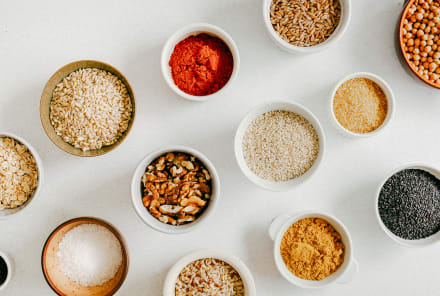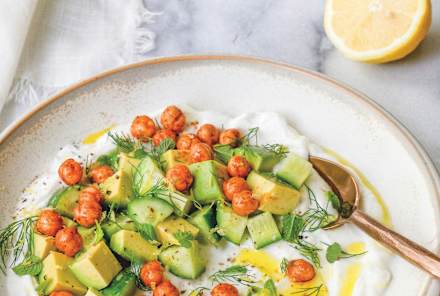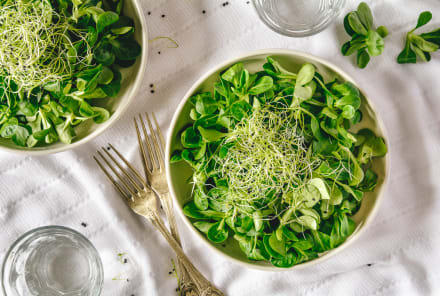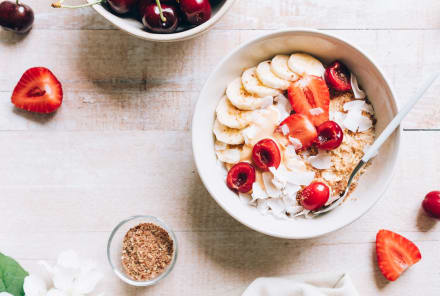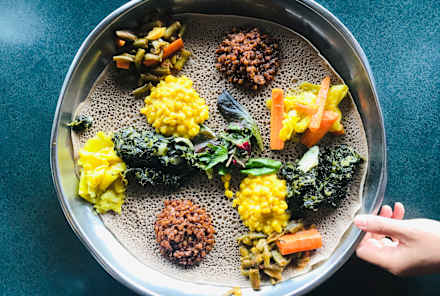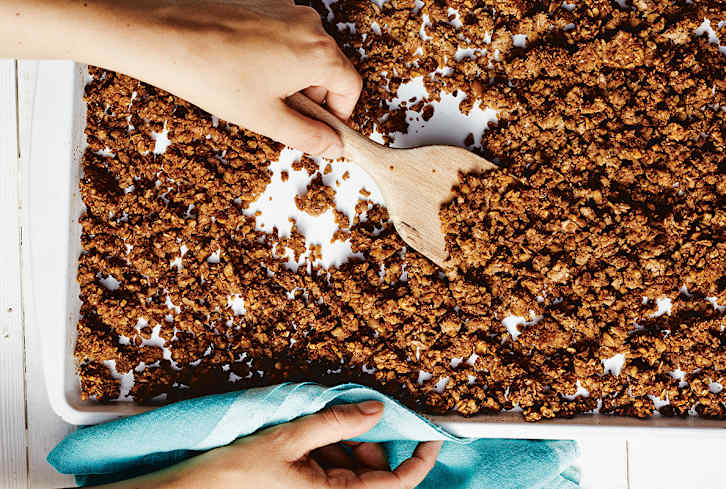Advertisement
5 Reasons To Eat Tahini + The Best Ways To Add To Your Diet


Nuts about nut butter? You're going to love tahini. Made of ground sesame seeds, tahini offers a richer, more savory flavor profile than your standard peanut butter. And it's way more versatile. It's just as good drizzled over greens as it is starring in a cookie recipe. Full of healthy fats, plant-based protein, and boasting benefits from heart health to glowing skin, tahini might just replace your favorite nut and seed butters.
Here, we break down all the science-backed health benefits of tahini and why you'll want to drizzle this seed butter on literally everything.
What is tahini?
Not so sure about this whole sesame-seed-butter business? Well, if you've ever had hummus, then you've had tahini. Besides chickpeas, tahini is one of the main ingredients of hummus. Popular in many Mediterranean and Middle Eastern dishes, you can also find it in babaganoush, an eggplant-based dip. Don't get us wrong, though, tahini is so much more than a behind-the-scenes ingredient. It shines as a salad dressing, swirled into blondies, or simply spread on toast. Sweet or savory, tahini does it all. You can even buy chocolate tahini spreads.
Ingredient-wise, tahini is just the paste of crushed sesame seeds; that's it. It does not need to be refrigerated before opening, so you'll likely find it in the condiments aisle hanging out with the other nut and seed butters, or check the international section of your grocery store. One tablespoon of tahini1 packs about:
- 90 calories
- 2.6 grams of protein
- 8 grams of fat
- 1.4 grams of fiber
- 64 mg of calcium
- 1.5 mg of iron
Bonus: Your nut-free friends can enjoy it too since tahini is technically a seed butter.
5 benefits of eating tahini.
As if you needed an excuse to eat more hummus, tahini, one of the main ingredients of hummus, is packed with vitamins, protein, and healthy fats. Read on for all the science-backed reasons to drizzle this superfood ingredient on every meal.
It's good for your heart.
Sesame seeds, the primary component of tahini, are known for their heart-healthy benefits. Specifically, they can help lower cholesterol. High cholesterol, especially LDL cholesterol, is a major risk factor for heart disease. In one study, patients with high cholesterol who ate 40 grams (about 4.5 tablespoons) of sesame seeds a day for two months saw significant improvements in total cholesterol2 and LDL cholesterol levels.
This may be because sesame seeds are packed with antioxidants, which protect cells from free-radical damage and prevent cardiovascular disease. Sesamin and sesamolin, in particular, are two potent antioxidants unique to the sesame plant that have been linked to heart health. They work by inhibiting cholesterol production3 in the body and blocking the absorption of dietary cholesterol.
It's may help fight inflammation.
It's becoming increasingly clear that inflammation is at the root of most chronic diseases. But, just as a poor diet can cause inflammation, a good diet can fight it. Integrative doctor Amy Shah, M.D., explains, "Food is the best lever for change in your inflammatory state. Eating more antioxidant- and polyphenol-rich foods can fight free radicals, which can calm inflammation." That's where tahini comes in.
The antioxidants in tahini, especially sesamin and sesamolin, can help fight inflammation4. In one study, patients with knee osteoarthritis5 who consumed 40 grams of sesame seeds per day saw improvements in knee pain and inflammatory biomarkers. Other lab studies have shown that the antioxidants in sesame seeds inhibit the production of inflammatory cytokines5.
It's packed with healthy fats.
Don't let the high-fat content of tahini scare you—it's all healthy fats. While the jury is still out on saturated fat, the kind of fat found in tahini—unsaturated fat—has long been regarded as "good fat." That's because it supports brain function, heart health6, and satiety.
In fact, the high-fat content of tahini may be another reason it is so good for your heart. Polyunsaturated fat7, the type primarily found in tahini, can help lower cholesterol.
It's a good nondairy source of calcium.
You probably associate calcium with milk and strong bones. As Jessica Cording, R.D., CDN, explains, "Calcium is a mineral that's important for building and maintaining strong bones and for carrying out a large number of body processes such as cell signaling involved in muscle and nerve function and helping blood vessels transport blood through the body."
Adults should aim to get about 1,000 mg of calcium per day8. But if you're living the dairy-free life, you might be worried you are missing out on this crucial nutrient. Not to worry, there are plenty of plant-based sources of calcium, including sesame seeds. Just 2 tablespoons of tahini provide almost 15 percent of the recommended daily allowance of calcium.
It makes your skin glow.
Looking to get glowing skin? Look no further than tahini. The nutrient composition of tahini makes it particularly well-suited for supporting skin health. All those good fats in tahini boost the absorption of fat-soluble vitamins like vitamin A and vitamin E, both of which are important for preventing visible signs of aging9. Plus, tahini contains zinc, a building block of the all-important-for-glowing-skin collagen. Collagen is what keeps our skin elastic and supple.
Tahini is also a source of plant-based iron. Maintaining proper iron levels, a concern for many vegans and vegetarians, is important for hair, skin, and nail strength.
While tahini is a delicious way to boost your vitamin and mineral intake, it is important to remember that all the great benefits it confers are within the context of a healthy diet. In general, try to eat whole-foods and a minimally processed diet, with plenty of greens and a drizzle of tahini on top, for optimal health.
How to add tahini to your diet.
Tahini is like the cool older cousin of your favorite nut butters. With a more subtle nutty flavor, it can be eaten straight from the jar, mixed with chickpeas for a classic homemade hummus, or poured into batter for a sweet treat. Try mixing it with basil, onions, garlic, and apple cider vinegar for a versatile green tahini sauce you can drizzle on roasted veggies all week. Or combine it with cacao and honey for a sweet morning spread. You can even use it to spice up your usual sandwich routine, swapping PB&J for T&J.
Just be wary of sesame allergies when sharing your new favorite ingredient with friends. While tahini is generally a safe alternative for those with nut allergies, it is estimated that 1.6 million Americans are allergic to sesame seeds.
9 Sources
- https://fdc.nal.usda.gov/fdc-app.html#/food-details/339493/nutrients
- https://www.ncbi.nlm.nih.gov/pubmed/22263599
- https://www.tandfonline.com/doi/full/10.1080/07315724.2015.1005198?src=recsys
- https://pubs.acs.org/doi/pdf/10.1021/bk-2012-1093.ch019?src=recsys
- https://www.ncbi.nlm.nih.gov/pubmed/28105144
- https://www.ncbi.nlm.nih.gov/pubmed/25161045
- https://www.heart.org/en/healthy-living/healthy-eating/eat-smart/fats/polyunsaturated-fats
- https://ods.od.nih.gov/factsheets/Calcium-HealthProfessional/#en1
- https://www.sciencedirect.com/science/article/pii/S0923181110000782

Why Nutrition Is Key To Changing Your Relationship With Alcohol
Brooke Scheller, DCN, CNS

Why Alcohol Sabotages Your Gut Health & How To Get Back On Track
Brooke Scheller, DCN, CNS

Why Nutrition Is Key To Changing Your Relationship With Alcohol
Brooke Scheller, DCN, CNS

Why Alcohol Sabotages Your Gut Health & How To Get Back On Track
Brooke Scheller, DCN, CNS

Why Nutrition Is Key To Changing Your Relationship With Alcohol
Brooke Scheller, DCN, CNS

Why Alcohol Sabotages Your Gut Health & How To Get Back On Track
Brooke Scheller, DCN, CNS

Why Nutrition Is Key To Changing Your Relationship With Alcohol
Brooke Scheller, DCN, CNS

Why Alcohol Sabotages Your Gut Health & How To Get Back On Track
Brooke Scheller, DCN, CNS
